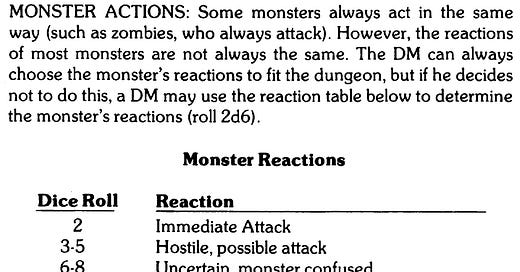The Most Powerful Ability in Dungeons & Dragons
Motivations in Roleplaying Game Economies Part 9/10
Welcome to Part 9 of Motivations in Roleplaying Game Economies. You can find Part 1 here. In this series we discuss how games affect the behavior of their players, using Dungeons & Dragons: Basic Set (1981, Ed. Tom Moldvay) as our example text. Part 9 examines the most powerful ability in the game… No spoilers. Read on!
You encounter three alchemists. Roll 2d6 to determine your reaction to their revelation and then another 2d6 to determine your distance in 10s of feet from the alchemists.
Monstrous Action-Reaction
While other dungeoneering tactics like the use of oil and planned surprise can increase survivability, true experts in this game know that to avoid fights, Charisma is the greatest resource. Nearly every encounter in the dungeon begins with a roll on the Monster Reactions table and a high Charisma score grants access to favorable results on the table which can lead to alliances, trickery or even treasure directly.
Here, we assess the viability of engaging with the encounter system and optimizing its Monster Actions rules to the benefit of the adventurers. While text grants the dungeon master some latitude to determine monster actions, the table provided on page B24 presents an interesting set of options.
We are fascinated by these Monster Actions/Reactions rules. They seem to point to a different type of dungeoneering philosophy than the typical idea of the game. Any group that refrains from going forth with swords-a-blazing at every encounter in the dungeon has a ~3% chance of finding “enthusiastic friendship.” Through this result, I once witnessed an unlikely bond form between an elf and a minotaur. Suffice to say it was life-changing for both.
Charisma Is OP
Factor positive Charisma modifiers of +1 or +2 into the reaction rolls, and the odds of avoiding immediate attack become guaranteed and the chance of overall neutral or positive reaction becomes 83.34% (+1) and 91.67% (+2) respectively. These numbers outstrip the 81% efficiency of a first level fighter against a goblin and the Sleep spell’s utility against groups of monsters. Furthermore, we must point out that this tactic works against nearly any monster encountered and can be leveraged by any character with a Charisma of 9 or higher, regardless of class or combat ability or spell casting capability. And, most important, it works against groups of creatures.
The pay-off for these overtures is substantial. Even a neutral reaction provides adventurers the opportunity for avoidance, tactics and trickery. Whereas, a positive reaction makes possible an alliance that either improves the group’s combat power, grants intelligence of lurking threats or, best case, leads the group straight to treasure. Savvy players, those who have climbed the heuristics tree to the plateau of exploration, know that the Charisma-Reaction play is essentially an optimal strategy in dungeoneering, and since this ability is independent of class, it invites collaboration and coordination from all players, and allows clever, personality-rich characters to come to the fore of the action.
I hope our analysis resulted in an Enthusiastic Friendship result (I promise we’d never abuse our new bond). Next week, we conclude our Motivations in Roleplaying Game Economies series. What have we learned? Find out here.
Until then we are, as ever, your Ludological Alchemists.
Want more? You can also listen to our companion podcast, The Hypothesis, here.







